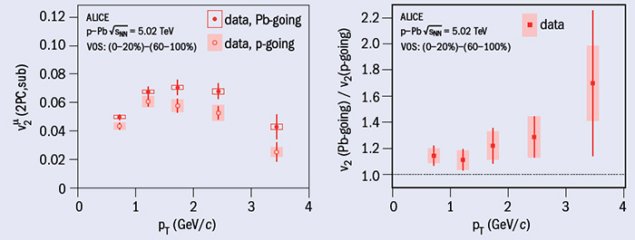
One of the hottest debates at the LHC is the potential emergence of collective effects in proton–lead (pPb) collisions, prompted by the discovery of double ridge structures in angular correlations of charged particles (CERN Courier March 2013 p6), and the dependence of the azimuthal asymmetry, characterized by its second Fourier coefficient v2, on particle mass (CERN Courier September 2013 p10). The experimental findings in pPb are qualitatively the same as those in PbPb collisions, and they are usually interpreted as hydrodynamic signatures of a strongly coupled, nearly perfect quantum liquid. However, QCD calculations, which invoke the colour-glass condensate (CGC) formalism for the gluon content of a high-energy nucleus in the saturation regime, can also describe several features of the data.

Thus, one of the key questions to answer is, whether the ridge is a result of final-state effects, driven by the density of produced particles, or of initial-state effects, driven by the gluon density at low-x. In the former case, v2 could be expected to be larger in the Pb-going direction, while it would be larger the p-going direction in the latter case.
The ALICE collaboration has recently completed a measurement to address this question in analysis of pPb collisions at a nucleon–nucleon centre-of-mass energy of 5.02 TeV. Muons reconstructed in the muon spectrometer at forward (p-going) and backward (Pb-going) rapidities (2.5 < |η| < 4.0) were correlated with associated charged particles reconstructed in the central (|η| < 1.0) tracking detectors. In high-multiplicity events, this revealed a pronounced near-side ridge at forward- and backward-going rapidities, ranging over about five units in Δη, similar to the case of two-particle angular correlations at mid-rapidity. An almost symmetric double ridge structure emerged when, as in previous analyses, jet-like correlations from low-multiplicity events were subtracted.
The v2 for muons, vμ2, in high-multiplicity events was obtained by dividing out the v2 of charged particles measured at mid-rapidity from the second-order two-particle Fourier coefficient, under the assumption that it factorizes into a product of muon v2 and charged-particle v2. The vμ2 coefficients were found to have a similar dependence on transverse momentum (pT) in p-going and Pb-going directions, with the Pb-going coefficients larger by about 16±6%, more or less independent of pT within the uncertainties of the measurement. The dominant contribution to the uncertainty arose from the correction for jet-like correlations affecting the extraction of v2.
The results add further support to the hydrodynamic picture, and are in qualitative agreement with model calculations incorporating final-state effects. At high pT (> 2 GeV/c), the measurement is sensitive to a contribution from heavy-flavour decays, and hence may be used to constrain the v2 of D mesons from calculations.





